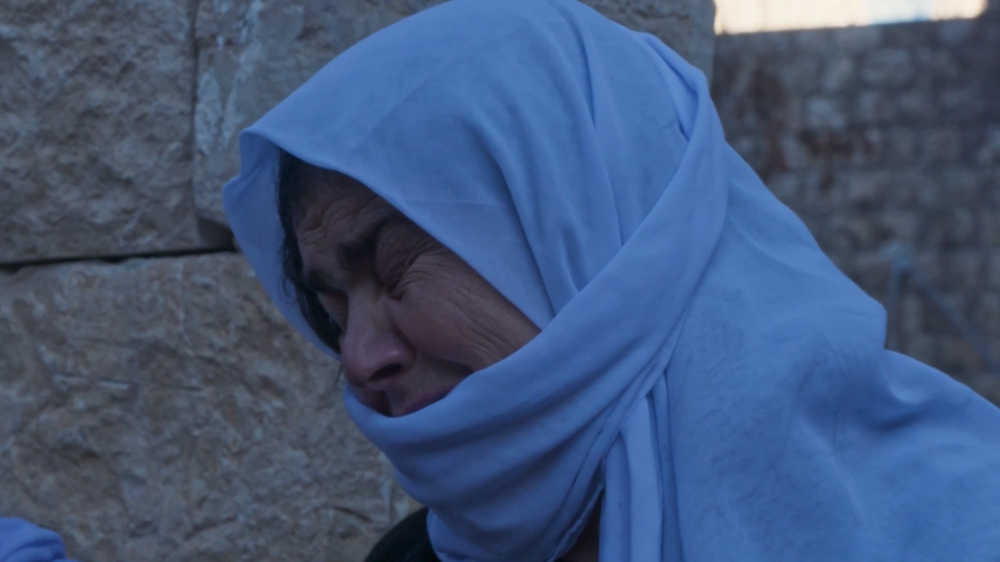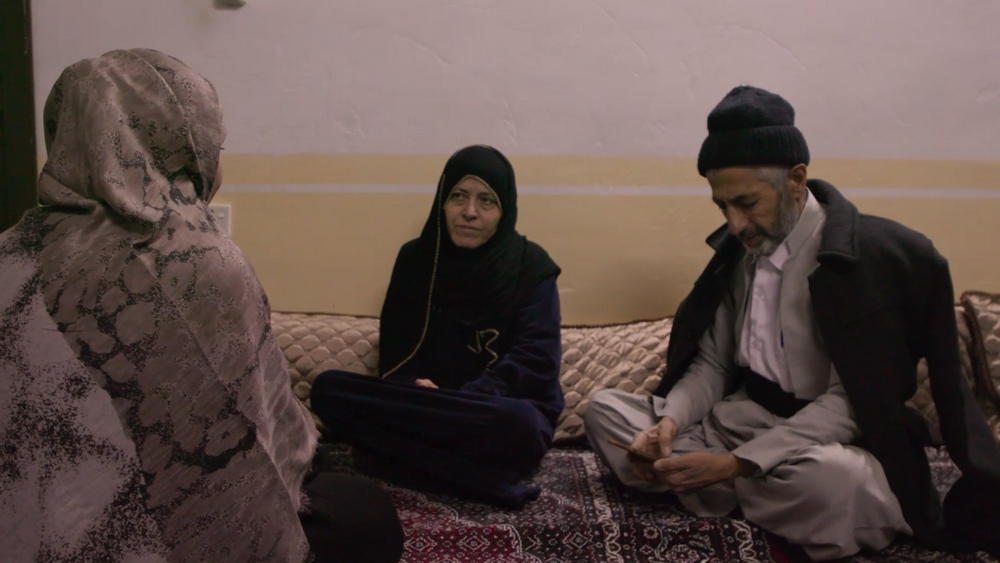Denied motherhood

The impossible nature of the scenario for these women (represented here by the single anonymous story of ´Ana´) is such that every utterance shared by the protagonist it is an invitation to the audience to step into these shoes. From the first few minutes, she is shown traveling in a car to a place that we will eventually come to know, while she shares a revealing description of her capture. In this telling, Jihadists would conduct a lottery to distribute young women as rewards. "My life will never be the same again" is how she will define the immediate moment following her rape, providing a clear kick-start to the drama.
The sustained account of the protagonist is the core of the documentary, which can be appreciated in two main dimensions. Firstly, the sharp character of the events as raw material, whose sensitivity drags the story as an open wound from start to finish (one hour and ten minutes). Its roughness is the essence, where for certain passages in the obvious absence of images of the sexual enslavement days, her calculated portrayal of the horrors experienced is the most insightful resource, to address the ethical dilemma of representability³ in human rights films; "Can and should atrocities and personal pain be represented visually?" (p. 422). The unspeakable landscape of the grotesque reality relies on the natural selection of words by the victim herself. As we have already seen in this field last year, for example, with the forceful work behind Hanna Polak’s documentary, Angels of Sinjar.
From a journalistic background, the good strike of achieving an interview with someone who, according to this piece, is one of the 'first mothers to break the silence' since their release in 2019, somewhat mirrors the author´s choice of a topic of human interest in the most traditional sense of the concept of news. This is given its significance of current affairs, urgency, and international resonance in connection to the realm of human rights.
 Still from the film
Still from the film
Alternatively, the author's ability to infuse her base interview with not only the documentary aspect desirable for a narration of this kind but also the appropriate cadence that, while allowing contemplation, avoids excessively long shots. This is in contrast to many other documentary works that, in pursuit of inspiring reflection or crafting aesthetics based on this, often fail to deliver further value. Perhaps due to her journalistic experience as a reporter, Pascale Bourgaux precisely manages not to get lost in the face of the elasticity option regarding sequential timings with which the documentary genre often tempts its authors.
The story is an immersion into the broken heart of the protagonist, spread out into a canvas of sober knowledge², where, devoid of unnecessary embellishments, it ends up being as straightforward as it is thoughtful. The relationship between what the documentary depicts (the representation) and the historical reality (what happened off-camera) finds a solid connection, with the real in an immediate and transparent way, triggering a justified belief¹ in favor of the documentary approach.
In the categorizations of the sociologist Kate Nash regarding her cinematic keys to achieving justified belief in human rights cinema, authenticity¹ (pp. 197-201) is present here in the following aspects. On one hand, through the link and interest that Bourgaux has been cultivating over the years with previous audiovisual cultural incursions from the Middle East (Les Larmes du Seigneur Afghan (2012) and The Prayers of a Warlord (2003) leading up to this latest proposal. Additionally, being a female filmmaker tackling a subject of this category adds to the verisimilitude parameter in the context of the mentioned framework.
On the other hand, the credibility of the protagonist who bears the weight of the narrated abuses, emerges as a character with a life vastly different from that of an average woman, creating for the audience both sober knowledge for its grounded quality, and immersive for inviting the viewers to learn about other people's lives while encouraging them to judge for themselves on what is happening. This, based on a clean narrative where the author does not interfere in the audio-visual proposal.
Regarding Nash’s reflexivity¹ (pp. 201-204) it would not be accurate to establish that partiality – whether deliberate or not – is used as an inherent strength of the strategy to create verisimilitude. It cannot be claimed that there is an interpretation of the facts to the extent that they are transformed into something other than the objective struggle for a mother's right to raise her child. Common sense in the context of human rights indicates that the truth of this protagonist must be accepted without questioning her position as an obvious victim. It is not about prioritizing the perspective of one side in a war, (E.g. Waltz with Bashir, 2008) but about the undeniable consequence of the children´s banishment.
As for ambivalence¹, (pp. 204-208) as the third documentary mechanism mentioned by Nash, it is crucial not to lose sight of the analysis of separating the savagery of terrorism and its consequences from the distinct problem that is the Yazidi people denying the integration of these children, being the latter the primary focus of the documentary. Both aspects are part of a whole; however, even here, the notion that "there are always different ways to judge what happened, what it means, and how it should be evaluated" shows up too, as Nash puts it. (p. 205).
 Still from the film
Still from the film
This ambiguity places truth as a perspectival, supported with particular strength in the sequence at the Holy Shrine of the Yazidis with the account of another woman as a tertiary character, who as she pointed out, was fortunate not to have become pregnant during her days of sexual slavery. In her confession about these children: "Their fathers are repulsive; we don’t want their kids to live with us", one could argue that a standpoint of distance from the existing problem it is observed, which turns out to be almost hypocritical given her condition as a victim of the same hell. However, it also constitutes a narrative that underscores not losing sight of the unrelenting hatred against those who harmed them for a lifetime and how each woman is affected differently.
Few things can be as harsh as facing the dilemma of raising a child conceived through rape (here, systematic). Nothing is obvious in the face of this emotional internal conflict. A decision that, for mental well-being, belongs solely to the mother. In the film, the statement from the Head of the Women´s and Orphanages´ Committee, reflects precisely the two radically opposed ways of addressing the conflict: Some women leave their children for good claiming no obligations to raise them, while others do so promising one day being able to get them back.
A feature film that combines direct cinema with journalistic documentary, where the – always seemingly – non-interventionism of the author is crucial to delicately envelop the fragility and loneliness of this personal story. A substantial and well-rounded work that manages to describe an indisputable truth – mothers in agony longing to raise their children – beyond the horrors that originated it in the context of the historical conflict; a subject of stimulation for other documentaries.
Through the paternal grandparents of Ana´s daughter, (who took on her upbringing), the film also highlights how, when people have endured so much suffering, human common sense encourages putting religions, beliefs, and practices into the background. Notably, it is the very grandmother of the girl who states: "We don't believe in differences between religions... we just want peace". This idea, is illustratively another revealing reference point for understanding the flexibility of religious nuances in the conflict, depending on who the different involved participants are.
The girl's phone call to her mother as she drives away inside after visiting her is an audio-visual conclusion as simple as it is effective, for a story that ultimately with all its complexity, is nothing more than a portrayal of the natural desire and human right of a mother and her daughter to want to be together.
The film brings to light the impracticality of the situation for victimized women who choose motherhood in an environment that does not support such a choice. Worse still, with authorities that deny the existence of these banished children when, in the end – considering that mothers like 'Ana' are willing to abandon everything for reunification – the impossibility of the right to parenting becomes more subject to the lack of means than to the imposition of the values of the community to which they belong. The blind eye turned by third-party actors such as those in the political sphere who could help this group of women is sordid, and their condemnation is neatly exposed to public scrutiny in the documentary's expositional format, given the helpful denunciatory nature of Pascale Borgeaux’s film.
References:
¹ Nash, Kate: Knowing Through Human Rights Films. Human Rights Quarterly 44. (2022).
² Rangan, Pooja: For a Critique of the Documentary Logic of Sobriety. World Picture (2014).
³ Swimelar, Safia: Making Human Rights Visible through Photography and Film. The SAGE Handbook of Human Rights (2014).
Daniel Sepúlveda
ELTE BTK Film Studies



